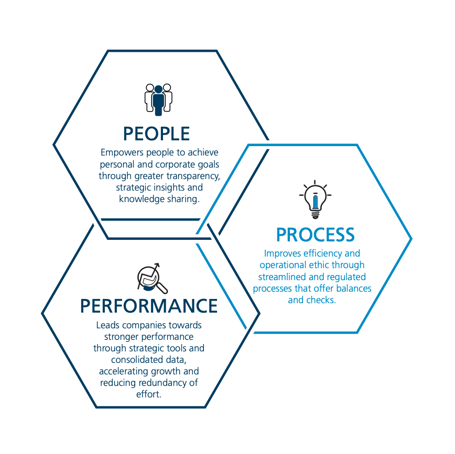Corporate governance is an important framework for ensuring efficient, profitable, and ethical advancement of your businesses. Digitizing the framework requires reform across all levels of the organization and will be a rewarding effort in the long-term.
It is no longer sufficient to merely move an organization’s manual processes to a digital platform to achieve digitization goals. With the rapid advancements in technologies, companies can reap the benefits of intelligent systems to accelerate business performance and optimize intra-company communication to a highly efficient level. Companies who have not yet caught up with the digital efficiencies will find that what they have to offer to both internal & external stakeholders and customers (including board communications) will be subpar in comparison to their peers in the field. Strategic planning in particular, will be hindered without the pace of information flow matching that of the market demands.
Understanding how digitization enhances corporate governance
Moving away from the traditional methods of operations and organizational bureaucracy is fundamental to successfully building yourself into a digitally savvy and advanced company. Everything from banking to government services happens at the click of a button through a handheld device that is authenticated and very often synchronized with other critical services. Everywhere you move, the cloud follows.
Corporate governance is often defined on the basis of the big ‘P’s – Process, People, and Performance. A good digital strategy and program for your company will connect the three seamlessly and ensure that you are in better control of the direction your company takes. At the crux of digital corporate governance is the ability to empower the company boards with tools to make better strategic decisions, and some of these decisions could very well revolve around improving the company’s digital strategy. Good digital corporate governance doesn’t stop at enhancing the capabilities at the top level. It starts bottom-up, with an advanced strategy to revolutionize how people and processes operate and lay the foundation for a forward-thinking organization.

The impact of technology on corporate governance
| Now | Future: Digital Corporate Governance | |
| Cybersecurity risks | High | Low |
| Efficiency | Low | High |
| Fairness | Not guaranteed | Guaranteed |
| Interactivesness | Low | High |
| Information symmetry | Not guaranteed | Guaranteed |
| Transparency | Low | High |
Capabilities of digital corporate governance solutions
Corporate governance technologies enable organizations to move a large part of their manual and paper-based workflows to online processes. Board portals and e-Meeting systems, which enable virtual meetings, are some of the ways to implement digital corporate governance Use of integrated solutions provided by a single service-provider at an enterprise level will ensure seamless data sharing, reduced security risks, and improved user experience. Digital corporate governance solutions come with the following core capabilities:
- Seamless transfer of manual/paper-based board meeting processes to a secure digital platform.
- Instant cloud-based access to board materials with granular file-level control.
- Virtual work groups for committee collaborations, commenting and discussion tools, project boards.
- Geographical mobility, multi-device support, and real-time data sharing abilities.
- Board pack creation, agenda building, attendance recorder, minutes publication, and action items management capabilities.
- Online proxy appointment/online voting.
- Virtual/hybrid meeting capabilities.
- Meeting management solutions to simplify administration of large-scale meetings like AGMs.
Transforming business operations through digital corporate governance solutions
Savings in cost, effort, time, and resources is certainly one of the primary administrative advantages of digital corporate governance solutions. However, at a larger level, they offer both tangible and intangible advantages including:
- Secured and improved collaboration: Digital tools offer geographic mobility and board members can collaborate easily from wherever they are, and on the go, in special and general meetings. Features like virtual rooms, discussion boards, and document sharing makes it even easier.
- Enhanced information flow: With an integrated interface and data hosting portal, sensitive and relevant documentation can be instantly made available to all entities, with provision for commenting/discussions around the topic. There is also greater accountability of action items and ownership of tasks.
- Increased participation: Hybrid or virtual meetings enable a greater number of board members/shareholders to participate and actively contribute to the strategic decision making.
- Transparency: A centralized system will make decisions, actions, and active discussions visible to all relevant entities, and help neutralize any internal power play dynamic. It further minimizes financial risk.
- Managing conflicts of interests: Timely access to information can help board members assess if they have potential conflicts of interest and take appropriate actions in board meeting and shareholders’ meeting. Some systems also offer forms for board members to declare their conflicts of interests.
- Access to historical records for reference: Management and administrators can have easy access to previous meeting agendas, notes, voting information, and annotations. Records also act as a ready safety net in the event of financial/regulatory audits.
Ensuring a framework for smooth implementation of digital corporate governance
Digital corporate governance systems must be well thought out and enable you to achieve the crucial goals of corporate governance. A high-level implementation requires that there be little room for error in terms of data security. Increasing governmental vigilance requires that you have an appointed team/member to ensure that your technical systems and corporate processes are both compliant with regulatory rules. Regular audits of technology partners/systems as well as ensuring relevant accreditations will go a long way in maintain corporate security and minimizing risk. However, not even the most secure system in the world is risk averse. It would be prudent to also have an action plan in place in the event a security breach may occur on your systems.
Needless to say, any implementation would be ineffective if clear cut processes and policies are not laid out for the staff to adopt in the move towards improved digitization. A move from paper to digital may inculcate a sense of insecurity in some of your core staff. Therefore, you may also want to include trainings to ensure that old schoolers have fully bought into the concept and that you are able to work through the resistance to change. A last but critical element of ensuring success in corporate digital governance is maintaining confidence of your largest stakeholder – the client or consumer. Data breaches are common and therefore in addition to ensure that your systems are exceptionally secure, effort must be put in to reassure and demonstrate the same to the external stakeholders.







